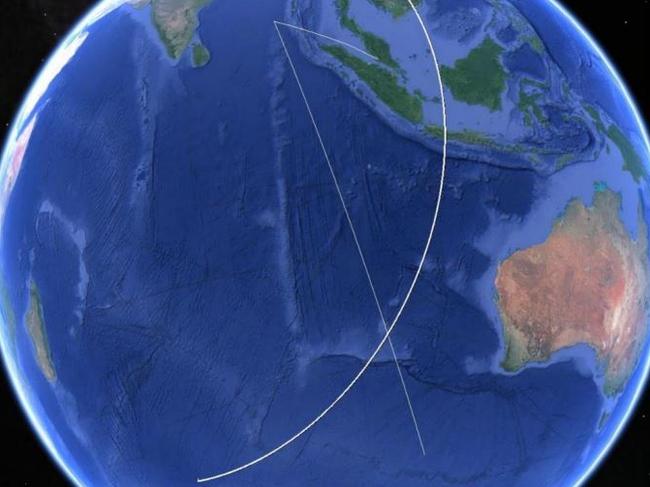MH370 missing five hours: Why did nobody raise alarm?
LESS than two minutes after its last transmission, something bad happened on MH370 at the worst possible moment.
WHAT happened to Malaysia Airlines flight 370 remains one of our greatest aviation mysteries.
What we do know is the flight left Kuala Lumpur just after midnight local time. It alerted air traffic control as it left Malaysian airspace, but the plane never flew over Vietnam as expected. Below is an edited extract from a new book examining the case, MH370 Mystery Solved by air crash investigator Larry Vance.
***
Malaysia Airlines Flight 370 (MH370) was a Boeing 777-200ER (B777) aeroplane that departed Kuala Lumpur International Airport in the dark of night, at 42 minutes past midnight local time on March 8, 2014. The destination was Beijing, China. On board were 12 Malaysian crew members, and 227 passengers.
The captain of the plane was Zaharie Ahmad Shah, who was 53 years old. He was married and had three children. Captain Shah had been an airline pilot with Malaysia Airlines for 33 years, and had 18,423 hours of flight time. He had been a B777 captain for 16 years, and had 8659 hours on that aeroplane type. By virtue of his good track record and seniority, he had been designated as a Type Rating Instructor, and Type Rating Examiner, on the B777. He was recognised as an accomplished and well-respected pilot who had no blemishes on his record.

The co-pilot of the plane was Fariq Abdul Hamid, who was 27 years old. He was unmarried. Co-pilot Hamid had been an airline pilot with Malaysia Airlines for seven years, and had 2813 hours of flight time. He was in the process of transitioning to the B777, and was just finishing his mandatory training to complete the transition. He had 39 hours on the B777.
MH370 was to be his final training flight prior to undergoing his “check ride”, which was to take place on his next scheduled flight. This type-check training is a normal process in airline operations. Captain Shah, as a designated Type Rating Instructor, was authorised to conduct such training on regularly scheduled flights.
The planned flight duration for MH370 was 5 hours, 34 minutes. The captain had ordered sufficient fuel for a flight endurance of 7 hours, 31 minutes, allowing some two hours of contingency fuel.
The flight departed normally from Kuala Lumpur, and climbed to its planned cruising altitude of Flight Level 350 (written as “FL350”, which is approximately 35,000 feet above sea level). It proceeded toward its first en route electronic waypoint — the IGARI waypoint. (Aeroplanes navigate along an assigned route by tracking through a series of fixed locations, known as waypoints, which provide a more-or-less straight-line track to their destination.)
About 37 minutes after departure, as the plane was approaching the IGARI waypoint, Air Traffic Control (ATC) cleared MH370 to switch to the communication radio frequency of the next control sector, where the pilot would be expected to report in.

In the area of the IGARI waypoint, the aeroplane was in a transition zone.
It would leave the airspace controlled by the Kuala Lumpur ATC sector, and enter the airspace controlled by the Ho Chi Minh ATC sector. The reply from the aeroplane to Kuala Lumpur ATC was, “Good night Malaysia Three Seven Zero”. As has been well documented, this was the final radio communication with MH370.
Less than two minutes after that final radio transmission, a significant anomaly occurred on board MH370. Something happened on the plane that caused it to disappear from all ATC radar screens. The electronic tracking signal from the aeroplane completely disappeared. This electronic signal is transmitted from the plane by a radio unit called a transponder. The transponder signal is sent in response to an interrogation from a ground-based radar facility. After the transponder signal disappeared from the radar screens, MH370 was essentially invisible to ATC.
From that point on, after the transponder signal disappeared, there was no more ATC interaction with MH370. There was no more voice communication with the aeroplane, and MH370 was no longer under any ATC control or monitoring.
Initially, the disappearance of MH370 did not raise any red flags with the controllers at ATC. This was because of the specific location where the transponder signal disappeared from the radar screens — just as the flight was being handed off from one control sector to the next. Investigators found that it had taken some time before the controller in the receiving sector noticed that an expected aeroplane (MH370) had not checked in, or shown up on his radar screen.

I have added the following commentary for context, and not to provide an excuse for ATC. A receiving controller is not necessarily focused on watching the radar screen for a handed-off plane to show up. Their primary responsibility is collision avoidance. ATC’s task is to ensure the track and altitude of the incoming aeroplane (MH370) do not conflict with another aeroplane in their sector. A receiving controller would know that the clearance delivery system would not have issued the assigned track and altitude for MH370 to enter their sector if a potential conflict existed. Also, there would be an expectation by the receiving controller that any aeroplane entering their sector would immediately check in, thereby drawing their attention. Most certainly the MH370 pilot would be aware of this dynamic, and that is why he chose this specific location to make his plane disappear.
Essentially, at 01.21 local time (39 minutes after departure) MH370 simply disappeared. It was only after some 17 minutes that the Ho Chi Minh ATC sector controller noticed that MH370 had not checked in, and that sector checked with the Kuala Lumpur ATC sector to see what might have gone wrong. The Kuala Lumpur ATC sector contacted the other ATC sectors along the flight-planned route, but none of them had established contact with MH370.
It was not until some five hours after MH370 had disappeared from electronic radar tracking that the Kuala Lumpur Rescue Coordination Centre was activated, and a search-and-rescue operation was initiated. ATC could not provide the Rescue Coordination Centre with any specific information about the whereabouts of the flight, other than where it was when it disappeared.
They had no way of knowing whether MH370 had landed, or crashed, or had flown on in some unknown direction.




